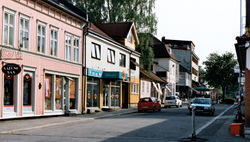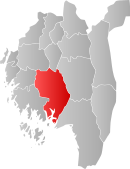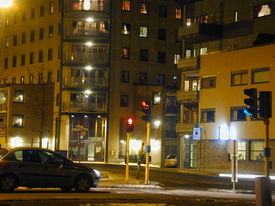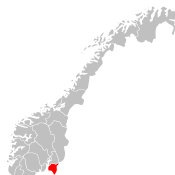Sarpsborg
| Sarpsborg kommune | |||
|---|---|---|---|
| — Municipality — | |||
 |
|||
|
|||
 |
|||
| Coordinates: | |||
| Country | Norway | ||
| County | Østfold | ||
| Administrative centre | Sarpsborg | ||
| Government | |||
| - Mayor (2003) | Jan O. Engsmyr (Ap) | ||
| Area | |||
| - Total | 406 km2 (156.8 sq mi) | ||
| - Land | 370 km2 (142.9 sq mi) | ||
| Area rank | 238 in Norway | ||
| Population (2006) | |||
| - Total | 52,159 | ||
| - Rank | 13 in Norway | ||
| - Density | 134/km2 (347.1/sq mi) | ||
| - Change (10 years) | 6.6 % | ||
| Demonym | Sarping[1] | ||
| Time zone | CET (UTC+1) | ||
| - Summer (DST) | CEST (UTC+2) | ||
| ISO 3166 code | NO-0105 | ||
| Official language form | Bokmål | ||
| Website | sarpsborg.com | ||
|
|
|||

Sarpsborg is a city and municipality in Østfold county, Norway. The administrative centre of the municipality is the city of Sarpsborg.
Sarpsborg is part of the fifth largest urban area in Norway when paired with neighbouring Fredrikstad. As of 1 January 2010, according to Statistics Norway these two municipalities have a total population of 125,797 with 52,159 in Sarpsborg and 73,638 in Fredrikstad.
Borregaard Industries is and always has been the most important industry in the city. The city is also the home of Borg Bryggerier, part of the Hansa Borg Bryggerier, Norway's second largest brewery-group.
Contents |
General information
Name
In Norse times the city was just called Borg (from borg which means "castle"). The background for this was the fortification built by Olav Haraldsson (see History section). Later the genitive case of the name of the waterfall Sarpr (now Sarpsfossen) was added.
In Norse times Østfold county was called Borgarsýsla which means "the county (sýsla) of Borg" and the law district of southeast Norway was called Borgarþing meaning "the thing/court of Borg".
The old name has been revived in the diocese of Borg (1968) and Borgarting Court of Appeal (1995).
Coat-of-arms
The coat-of-arms is from modern times. They were granted on 13 November 1991. It is based on a coat-of-arms from 1556. It shows a bear over a castle. The bear was introduced as early as sometime in the 13th century, by the earl of Sarpsborg (Comes de Saresburgh), Alv Erlingsson. He used the bear to symbolize his strength. The castle symbolizes the fortress (borg) that once gave the city its original name.[2]
History
The city was founded as Borg by the Viking King Olav Haraldsson (Saint Olav) in 1016. It was burned to the ground by Swedish invaders in 1567 during the Northern Seven Years' War. Half the population was evacuated down the river to what is today known as Fredrikstad, about 15 kilometres (9 mi) downstream. Much of the rebuilt town disappeared into the river Glomma during a 1702 mudslide. Again Borg was rebuilt, and it was recreated as a city in 1839, and separated from Tune as a municipality of its own. The rural municipalities of Tune, Skjeberg, and Varteig were merged with the city on 1 January 1992. The population is steadily growing, and during the summer of 2005 it reached 50,000 inhabitants.
City districts
- Hasle
- Sarpsborg
- Ise
- Skjeberg
- Alvim
- Greåker
- Grålum
- Borgenhaugen
- Klavestadhaugen
- Yven
- Høysand
- Varteig
- Hafslund
- Gleng
- Fritznerbakken
- Kurland
- Lande
- Valaskjold
- Brevik
Sport
In the 1960s, Sarpsborg was famous for its football (soccer) team, Sarpsborg FK, but is now more known for its ice hockey team, Sparta Warriors. In football, Sarpsborg 08 FF has taken over the local throne, currently playing on the 2nd highest national level, known as the Adecco League. On 6 November 2009, they sent arch-rival FFK down from the "Tippeliga" in a play-off game in Fredrikstad stadion. Sarpsborg BK plays in the highest bandy division.
Notable residents
- John Anderson (1873–1949), Major League Baseball player for fifteen seasons in the United States
- Arne Arnardo, Norwegian circus owner
- Harald Dahl, father of British author Roald Dahl
- Nadia Eide, actress, singer, dancer
- Jan Groth (1946–), vocalist/song writer/artist (Aunt Mary/Just4Fun/Oslo Gospel Choir/Aage Samuelsen tributes)
- Jonas Groth (1977–), artist/vocalist
- Stephan Groth (1971–), artist (Apoptygma Berzerk)
- Arnold Haukeland, artist (sculptor)
- Stian Joneid (1978–), artist/vocalist
- Trond Joneid (1948–2007), artist/vocalist/drummer (The Saints/Sirkus Sørensen)
- Raymond Kvisvik (1974–), soccer player
- Thomas Myhre, goalkeeper (soccer)
- Åge Sten Nilsen artist/vocalist/song writer ("Glam" from Wig Wam/The Show Must Go On (Queen Tribute)/Rondo)
- Robert Normann (1916–1998), legendary guitar player
- Nils Ole Oftebro, actor
- Per-Åge Skrøder, ice hockey player
- Jens Arne Svartedal, international skiing champion
- Oscar Torp (1893–1958), former Prime Minister of Norway
- Lene Alexandra Øien, glamour model
- Walther Aas (1928–1990), artist
- Ole Slorer Financial analyst
International relations
Twin towns - Sister cities
Sarpsborg has several sister cities:[3]
|
|
References
- Notes
- ↑ "Personnemningar til stadnamn i Noreg" (in Norwegian). Språkrådet. http://www.sprakrad.no/Sprakhjelp/Rettskriving_Ordboeker/Innbyggjarnamn.
- ↑ "Vedtak om bruk av byvåpenet i den nye kommunen". Sarpsborg. http://www.sarpsborg.com/portal/page?_pageid=33,3140&_dad=portal&_schema=PORTAL&articleId=11573&artSectionId=1246. Retrieved 2008-12-15. (Norwegian)
- ↑ "Vennskapsbyer". Sarpsborg kommune. http://www.sarpsborg.com/portal/page?_pageid=33,3140&_dad=portal&_schema=PORTAL&articleId=4271&artSectionId=1334. Retrieved 2008-12-15. (Norwegian)
- ↑ "::Bethlehem Municipality::". www.bethlehem-city.org. http://www.bethlehem-city.org/Twining.php. Retrieved 2009-10-10.
External links
 Media related to Sarpsborg at Wikimedia Commons
Media related to Sarpsborg at Wikimedia Commons- Sarpsborg travel guide from Wikitravel
- Some Photographs of Sarpsborg in August 1986, including the Victoria Hotell
|
|||||
|
||||||||||||||||||||||||||||||||||||||||||||||||||||||||||||||||||||||||||||||||||||||||||

